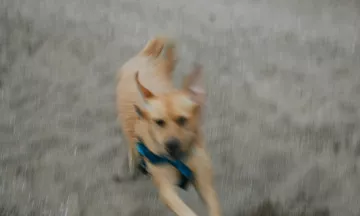It's a scary scenario for any dog owner: the thought of your dog in a fight. What can you do in case of a dog fight? And how can you prevent dogs from fighting in the first place? Here's what every dog owner and dog sitter should know.
Fortunately, most dogs don't start fighting 'just out of the blue'. They give clear warning signals before conflict arises. It's up to us dog owners and dog sitters to pay close attention to what happens when two dogs interact, either for the first time or any time they are together.
Preventing dogs from fighting
When two dogs are together, the most important thing is to prevent confrontation. And that happens very early during the meeting. When one dog doesn't like another dog, or doesn't want to interact in any way, this will be made very clear with visible stress signals:
- Licking lips
- Showing the whites of the eyes
- Yawning
- Tail down or between legs (demonstrating fear)
If a dog is angry, you can also tell by it's body language:
- standing still, staring or fixating
- Tail stiff and straight up
- Fur standing on end
- Raising lips and showing teeth
- Growling
If you see one or more of these signals from your own dog or from another dog, avoid any potential conflict by walking the other way. Always bring treats on a dog walk to distract your own or the other dog so that you give yourself the opportunity to get out of the situation.
Are you visiting a dog or is another dog visiting your house? Be sure to let the two dogs meet each other on neutral ground outside the home. Always give the dogs the space to leave if they get stressed and never, ever force two dogs to interact with or play with each other.
Pay attention: no phone during the dog walk
Many dog fights and bites can be prevented by simply paying attention. To prevent a potential conflict in advance, it's important to be alert during when your dog meets another dog on a walk.
Make sure that you can clearly see what is happening in case of other dogs approaching, so you can then properly assess the situation. Make it a rule to leave your phone in your pocket during a dog walk and stay focused.

Always pay attention to your dog and the environment during dog walks
What if a dog becomes aggressive?
If two dogs get hostile with each other (growling or biting), or when innocent play starts to get out of hand, it's important to remove the dogs from the situation as quickly as possible. Make sure to be clear and resolute, but never be aggressive or noisy as this can ignite the fight even more.
- Avoid the dogs from having eye contact by standing in between them (if it is safe to do so)
- Ask the other dog owner to call their dog to them
- Stay calm, don't shout. Also, ask bystanders to stay calm
- Don't 'joint the fight': kicking or hitting the dogs will only make things worse
- Walk away so your dog doesn't feel 'supported' by you, and call your dog.
- Distract the dogs with treats
- Say 'stop!' or 'no!'
In case of emergency: how to stop fighting dogs
If the dogs don't stop fighting and are only focused on each other, it's important to take action - intervention can save a dog's life. However, this can be very dangerous, so ask bystanders to help you and take care of yourself!
Ask for help and act quickly: You can separate fighting dogs by making them lose their balance - do this with assistance so that it can happen to both dog's at once. Simply lift a dog's hind legs and pull the dog slowly towards you. If it is too dangerous to grab the dog's legs, you can also use a coat, leash or belt to lift the dog by the legs. As soon as the dogs lose their balance, you can take them apart, leash them and take them somewhere safe.
Does one of the dogs have a grip of the other dog between the jaws? Hold the biting dog's head firmly to prevent it from shaking. Place a stick between the dog's jaws, making sure it sticks out on both sides of the mouth. This way you can open the dog's jaws like a jack.
If it's still not possible to make the dog let go, it may sometimes be necessary to squeeze the biting dog's throat until it relaxes and release. Please note: this is an extreme emergency measure and can only be applied if a dog's life is at stake. By choking the biting dog it may lose consciousness, so please remember that this is only for use in life-threatening situations.

Checklist: preventing dogs from fighting
Fortunately, many fights can really be prevented with these tips so that, hopefully, you will never face a situation like this. In short:
- Pay attention during the walk: no phones
- Observe stress signals from your own dog and other dogs
- Respect the space of other dogs
- When in doubt: leash your dog and ask the other dog owner to also leash their dog
- Not sure whether two dogs will like each other? Always walk away, distract your dog and avoid any contact
Inform your dog walker
Do you ever book a dog sitter at Pawshake? Always tell your dog walker clearly where and when the dog can walk off-leash and where and when you would prefer them not to.
Tell your dog sitter as much detailed information as possible about your dog's character so that you know when your dog is angry, scared or aggressive. That way, your dog walker can better assess the situation in the dog park and monitor your dog's safety during their walk.




